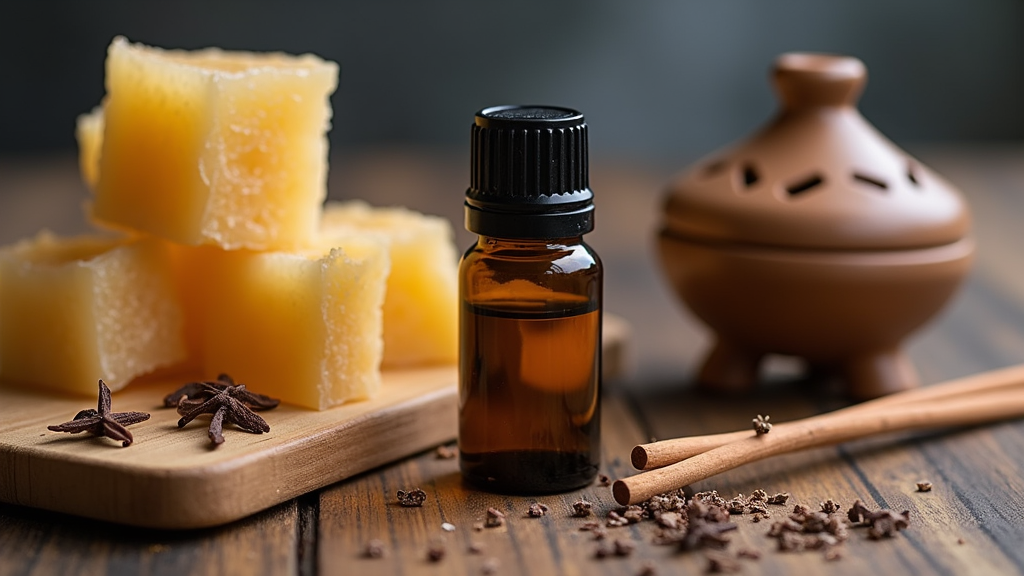Frankincense might look like just a crumbly resin at first glance, but there’s a reason it’s been valued for thousands of years across so many cultures. Whether you’ve seen it used in ancient rituals or noticed it as a modern essential oil, this aromatic treasure has plenty going on beneath the surface. I’m going to break down what frankincense is, share where it comes from, go through its uses, and offer some tips that help you get the most out of it if you’re curious.

What Exactly Is Frankincense?
Frankincense is a resin that oozes out from trees belonging to the Boswellia genus. These trees mostly grow in dry, mountainous regions across Africa and the Middle East; think Oman, Somalia, Ethiopia, and Yemen. When the trees’ bark is cut, a sticky sap starts to flow. After a few weeks exposed to air, it hardens into the transparent, golden nuggets known as frankincense.
Frankincense has a strong, earthy scent with a bit of citrus and pine, which makes it really popular for incense and perfumes. The resin has a reputation for being super valuable—people traded it across continents in ancient times, and high grade frankincense still runs pretty pricey.
This resin is used both whole and in processed forms. You’ll see it burned as incense, ground up for powders, or distilled into essential oil. Frankincense essential oil in particular has brought it back into the spotlight with all sorts of wellness trends. Many folks find the scent to be grounding and unique, which is part of why it continues to show up in various products beyond just incense sticks.
Where Does Frankincense Come From?
The story of frankincense begins mostly with the Boswellia sacra and Boswellia carterii trees. These trees only grow in places where the climate is hot and arid. It takes years before a Boswellia tree is mature enough to harvest; the best, most aromatic resin comes from older trees.
The process for collecting frankincense is pretty hands on. Experienced harvesters carefully score the bark to release the sap. The resin has to be left alone to dry out, then collected by hand. This approach has barely changed in centuries, a testament to the care taken to preserve both tree health and resin quality. The harvester’s skill greatly affects the purity and aroma of the final product.
Main Uses for Frankincense Resin and Oil
The number of ways you can use frankincense is huge, from practical to spiritual to beauty related. Here’s a breakdown of what’s most popular today (and why people reach for it):
- Incense and Ritual Burning frankincense is an ancient tradition. You’ll smell it in some churches, temples, or during meditation sessions. The slow burning scent is believed to encourage mindfulness and a calm vibe. Some people say it helps clear negative energy from a space, making it a top pick for ceremonies and home rituals alike.
- Aromatherapy Essential oils made from frankincense resin are widely used in diffusers or baths. Many fans say frankincense aroma is grounding, improves mood, and can help take the edge off stress. The unique scent profile can transform the atmosphere of a room and give a boost to relaxation times.
- Skincare Frankincense’s anti inflammatory properties are well liked in the skincare world. You might find it in creams, serums, and oils for the face. Some users dab diluted frankincense oil on blemishes or irritated skin, expecting a soothing effect. There’s also a growing interest in how frankincense may help with scars and overall skin tone, though more research is needed.
- Traditional Medicine In places like India and North Africa, frankincense has been used in traditional health practices for centuries. It’s used in Ayurveda, and is studied for possible benefits in joint health and respiratory support. Keep in mind, though, research is still ongoing in this area, and while many swear by it, clinical evidence is just beginning to catch up.
- Home Fragrance Beyond incense, frankincense oil is found in candles, sprays, and even some furniture polishes. Its scent mixes well with citrus, myrrh, or spices for a cozy environment. Many people like the way it can provide a comforting background aroma that lingers for hours.
Getting Started With Frankincense: What Newbies Should Know
Frankincense can seem mysterious at first, but jumping in is pretty simple. Here are a few things I always keep in mind when using frankincense oils or resin for the first time:
- Quality Matters Not all frankincense on the market is the same. Look for sources that tell you what species it comes from, and pick well known brands or smaller sellers who describe their harvesting methods. Quality resin will have fewer impurities and a cleaner, stronger scent.
- Choosing a Form Frankincense appears as raw resin chunks, essential oil, powders, or pre made products like creams and candles. Think about how you want to use it—resin is great for incense, oil is versatile for diffusers and beauty, and powders work for quick DIY blends.
- Safe Use For the essential oil, always dilute it before putting it on your skin. Patch tests are super important if you’ve never used it before, just in case of a reaction. Burning resin should be done in well ventilated spaces, and keep it away from anything flammable.
Troubleshooting and Common Mistakes When Using Frankincense
Most issues with frankincense come down to overuse or not quite knowing what you’ve bought. Here are a few common hiccups and how to avoid them:
- Overpowering Scent Frankincense’s aroma is pretty strong. If you’re using oil in a diffuser, a few drops go a long way. For incense, using just one or two pieces of resin at a time works well for a smaller room.
- Skin Irritation Applying undiluted frankincense oil straight to the skin can be uncomfortable (sometimes even painful). Always mix it with a carrier oil like jojoba or sweet almond to tone down potential irritation.
- Fake or Adulterated Products The high demand means some companies mix frankincense with other substances to stretch out their supply. If the price seems too low, or there’s no info about the source, the quality could be off. Buying from reputable or transparent sellers lowers the risk of disappointment or poor results.
https://referral.doterra.me/4740777
“Here’s a little transparency: Our website contains affiliate links. This means if you click and make a purchase, we may receive a small commission. Don’t worry, there’s no extra cost to you. It’s a simple way you can support our mission to bring you quality content.”
Best Practices for Using Frankincense Safely
Here’s how I personally approach frankincense so that it stays enjoyable:
- For incense, use a heat safe burner with a bit of sand to keep things contained. This also lets you clean up easily after a session.
- If you want to try frankincense in your skincare, look for products where frankincense oil is already blended in, or start with a very diluted mixture—like one or two drops per tablespoon of carrier. Be sure to do a patch test, just to check for any sensitivities.
- Diffusers bring the scent into a room beautifully, but ventilate by opening a window if the scent is too much. Moderation is key; too much resin or oil can overwhelm a small space.
- Keep all frankincense oils and resins away from kids and pets. They’re not safe to eat and can irritate little noses and skin. Store products safely to avoid accidents.
Some Cool Features of Frankincense That Make It Worth Considering
- Long History Frankincense has been involved in trade, medicine, and religion for over 5,000 years. Getting to use it today feels like tapping into a living tradition. Knowing you’re sharing in a piece of global heritage adds meaning to modern routines.
- Complex Aroma The scent is a layered mix of pine, lemon, and wood, which brings more character than many single note oils or incense sticks. This complexity allows it to fit many different moods and settings.
- Mixes Well With Other Oils If you enjoy blending essential oils, frankincense combines nicely with lavender, orange, cedarwood, and myrrh for custom scents. Creating your own signature blend can make your space feel unique and welcoming.
Real World Uses: How People Incorporate Frankincense
- Meditation and Yoga Spaces A small chunk of resin gently smoked creates an inviting and grounding backdrop for relaxation. Many people like starting sessions with the calming aroma in the air, helping to set the tone for deep focus.
- DIY Skincare Some folks add a drop of diluted frankincense oil to their moisturizer or bathwater, aiming for a unique boost. It’s often paired with other skin friendly oils like rosehip or chamomile for an upgraded home routine.
- Holiday Traditions Frankincense has a part in many Christmas celebrations, both in church and at home. It brings a certain festive, ancient vibe that’s tough to match, with the scent instantly calling to mind stories from the past and special holiday moments.
Frequently Asked Questions About Frankincense
Here are a few of the most common questions I hear from people curious about trying frankincense:
Question: Is frankincense safe to use every day?
Answer: For most people, diluted frankincense oil or incense can be used regularly without trouble. Just watch out for any allergies or sensitivities, especially if it’s your first time. Always pay attention to how your body responds and make adjustments if needed. Take a break occasionally if you notice irritation or discomfort.
Question: What’s the difference between frankincense and myrrh?
Answer: Both are tree resins with long histories. Frankincense has a more citrusy, piney scent, while myrrh is deeper and smokier. They’re often teamed up in blends or rituals, playing off each other’s strengths in both fragrance and tradition.
Question: Can frankincense oil be ingested?
Answer: It’s not recommended to eat or drink frankincense oil or resin without guidance from a licensed healthcare provider familiar with essential oils. Stick to external and aromatic uses for safety—if you’re considering internal use, definitely ask a professional who knows about essential oil safety first.
Last Thoughts On Frankincense
Frankincense brings together a fascinating blend of tradition, fragrance, and wellness in a way that still feels meaningful today. Whether you burn the resin for a soothing evening, use a drop or two of oil in your skincare routine, or add it to your diffuser, this resin is all about balance and relaxation. Taking the time to pick high quality frankincense and trying out different forms can help you figure out what suits your lifestyle best.
Curiosity goes a long way with frankincense, so explore and see how this ancient resin might fit in your daily routine. If you want to learn more, check out resources on essential oil safety or the history of Boswellia trees for some interesting background info. Feeling inspired? Try experimenting with different ways of using frankincense and see what kind of routines become new favorites.
